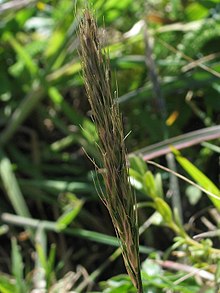| This article needs additional citations for verification. Please help improve this article by adding citations to reliable sources. Unsourced material may be challenged and removed. Find sources: "Trisetum canescens" – news · newspapers · books · scholar · JSTOR (November 2010) (Learn how and when to remove this message) |
| Trisetum canescens | |
|---|---|

| |
| Scientific classification | |
| Kingdom: | Plantae |
| Clade: | Tracheophytes |
| Clade: | Angiosperms |
| Clade: | Monocots |
| Clade: | Commelinids |
| Order: | Poales |
| Family: | Poaceae |
| Subfamily: | Pooideae |
| Genus: | Trisetum |
| Species: | T. canescens |
| Binomial name | |
| Trisetum canescens Buckley | |
Trisetum canescens is a species of grass known by the common names tall trisetum and tall false oat.
Distribution
The bunchgrass is native to western North America from Alaska and British Columbia to central California and Arizona, where it occurs in forests, mountain meadows, and streambanks, being most common among Ponderosa pines and stands of spruce and fir.
Description
Trisetum canescens is a perennial bunchgrass forming clumps of erect stems up to 50–80 centimetres (20–31 in) tall, but known to exceed 1 metre (3.3 ft).
There are three to four leaves per stem, the blades reaching up to 30 centimeters in length. The sheaths can be hairless to quite hairy, the hairs sometimes long and shaggy.
The inflorescence is an open or compact panicle of green, tan, or purplish spikelets up to 20 centimeters long.
References
- NRCS. "Trisetum canescens". PLANTS Database. United States Department of Agriculture (USDA). Retrieved 15 December 2015.
External links
- Jepson Manual Treatment: Trisetum canescens
- Grass Manual Treatment — Trisetum canescens
- Trisetum canescens — U.C. Photo gallery
| Taxon identifiers | |
|---|---|
| Trisetum canescens |
|
This Pooideae article is a stub. You can help Misplaced Pages by expanding it. |
- Trisetum
- Bunchgrasses of North America
- Grasses of the United States
- Grasses of Canada
- Native grasses of California
- Flora of Alaska
- Flora of British Columbia
- Flora of the Northwestern United States
- Flora of Arizona
- Flora of the Sierra Nevada (United States)
- Natural history of the California Coast Ranges
- Pooideae stubs